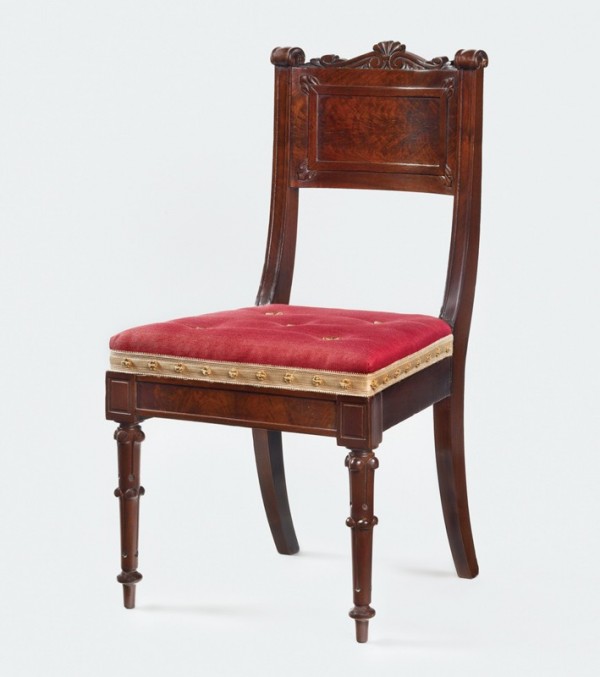
Side chair attributed to Richard Parkin, Philadelphia, Pennsylvania, 1834–1840. Walnut and walnut veneer with tulip poplar. H. 32 1/4", W. 18", D. 18". (Courtesy, Carswell Rush Berlin, Inc.; photo, Gavin Ashworth.)
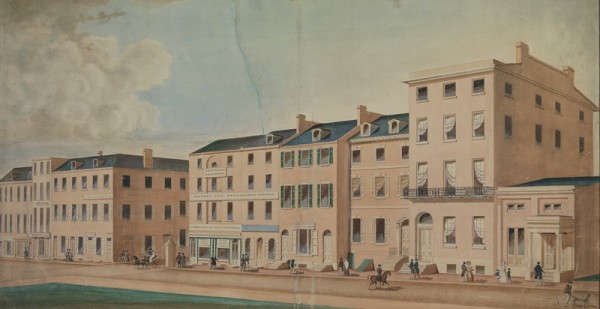
View of Walnut Street between Third and Fourth Streets, Philadelphia, Pennsylvania, 1830–1840. Watercolor on paper. 18 3/4" x 33 1/2". (Courtesy, Library Company of Philadelphia.) Cook and Parkin’s shop is in the middle of the block on the left. John Hancock and Company occupied the building on the left corner. As was the case with Cook & Parkin, Hancock’s business was in the central business district. Only the most successful firms could afford to operate at that location.
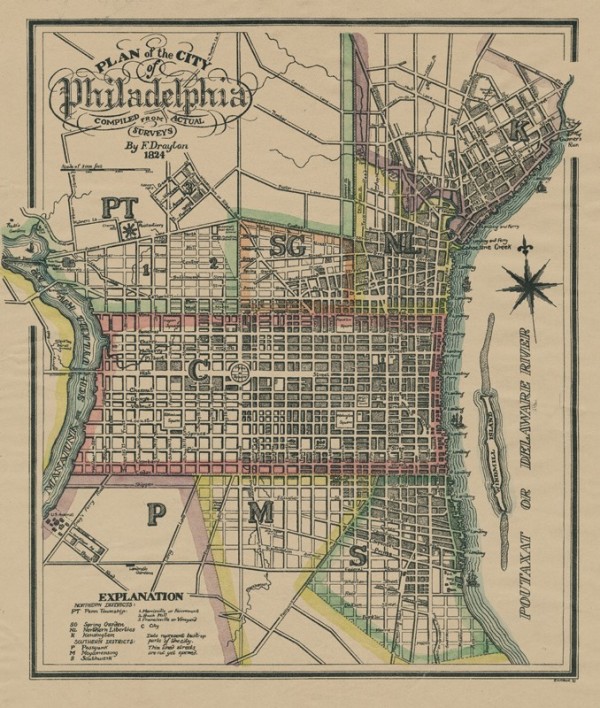
Joseph Drayton, Plan of the City of Philadelphia, published by H. C. Cary and I. Lea, Philadelphia, Pennsylvania, 1824. Hand-colored engraving on paper. 15 1/2" x 17 194". (Courtesy, Historical Society of Pennsylvania.) This detail shows the central business district and the locations of businesses maintained by Cook & Parkin, Thomas Cook, and Richard Parkin.
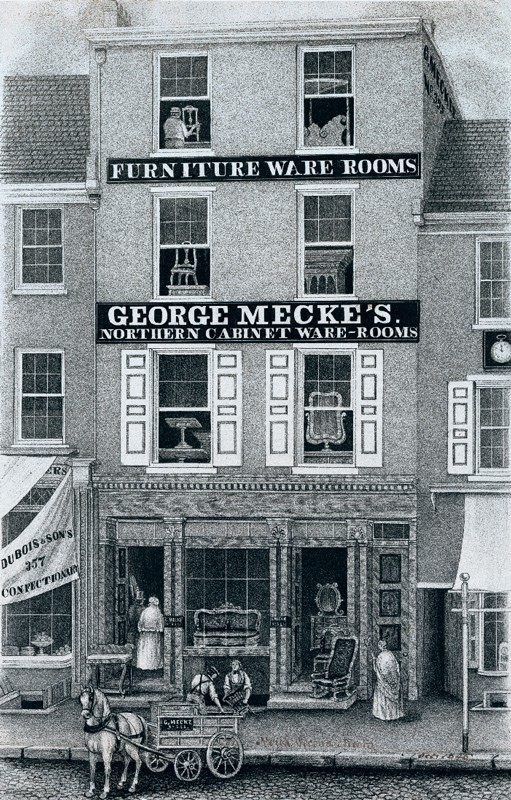
W. H. Rease, engraver, “George Mecke Cabinet Maker and Upholsterer,” published by Wagner and McGuigan, Philadelphia, Pennsylvania, 1846. Lithograph. 20" x 13". (Courtesy, Arader Galleries, Philadelphia.) This lithograph shows the shop of cabinetmaker George Mecke at 355 North Second Street. The building is a typical Philadelphia row house with a cabinet shop in the front.

A Shop Front in the Egyptian Style (Courtesy, Sir John Soane’s Museum, London.) The façade of Parkin’s shop may have resembled this storefront in the Egyptian style. In addition to a new façade, the redesign of Parkin’s shop opened the show room to the street, making it more inviting and conducive to display.

Egyptian Hall, designed by Peter F. Robinson for George Bullock, Piccadilly, London, 1811–1812. (Courtesy, Sir John Soane’s Museum, London.)

Sideboard bearing the label of Cook & Parkin, Philadelphia, Pennsylvania, 1819–1824. Mahogany and mahogany veneer with white pine, tulip poplar, and oak. H. 63 1/4", W. 98 1/2", D. 24 3/4". (Courtesy, Baltimore Museum of Art; purchase fund with exchange funds from gift from estate of Margaret Anna Abell, gift from Mr. and Mrs. Warren Wilbur Brown, gift of Jill and M. Austin Fine, bequest of Ethel Epstein Jacobs, gift of William M. Miller and Norville E. Miller II, Bequest of Leonce Rabillon: Bequest of Philip B. Perlman; and Gift of Mr. and Mrs. Louis E. Schecter, BMA 1989.26; photo by Mitro Hood.)
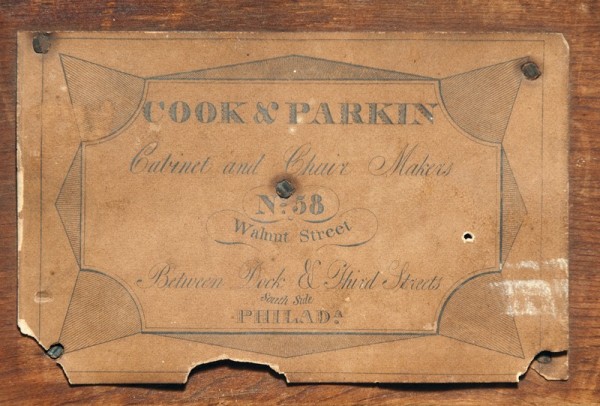
Detail of the label on the sideboard illustrated in fig. 7.
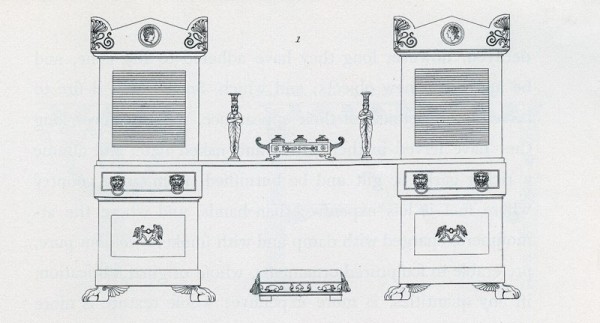
Design for a “large library or writing-table flanked with paper presses, or escrutoirs,” illustrated in pl. 11 in Thomas Hope, Household Furniture and Interior Decoration (London, 1807).
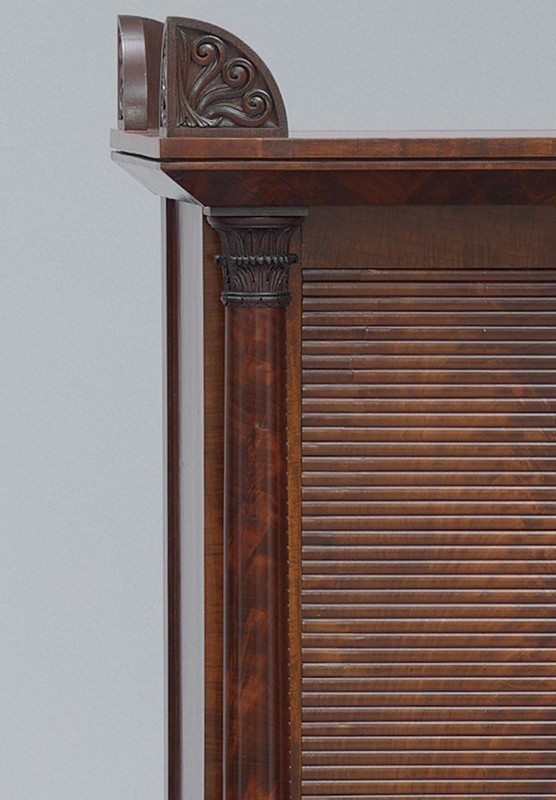
Detail of a Pergamene capital on the sideboard illustrated in fig. 7.
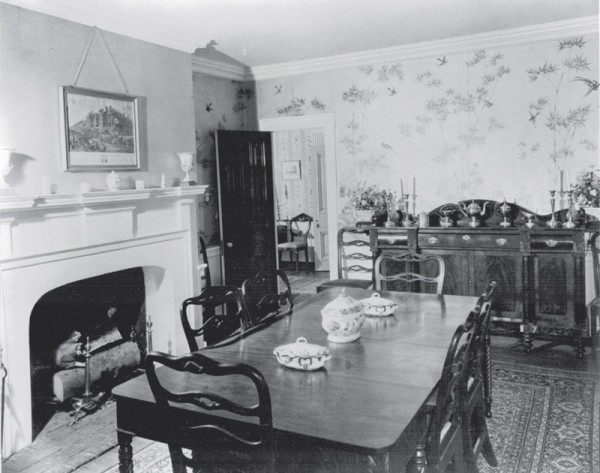
Photograph showing the dining room of the Anthony Wayne House, Easttown Township, Paoli, Pennsylvania, 1930–1940. The sideboard has later brass drawer pulls.

Pier table bearing the stenciled label of Cook & Parkin, Philadelphia, Pennsylvania, 1825–1830. Mahogany and mahogany veneer with white pine and tulip poplar; marble. H. 40 3/4", W. 47 3/4", D. 20". (Private collection; photo, Johnny Miller.) A molding with a cavetto frieze of similar profile is illustrated in pl. 1 in the Philadelphia Cabinet and Chair Makers’ Union Book of Prices (1828).
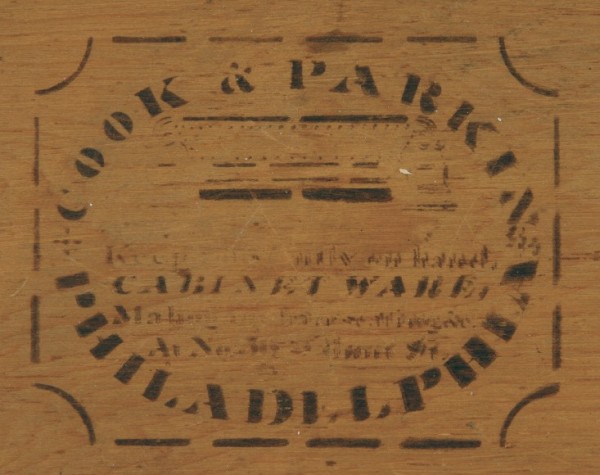
Detail of the stenciled label on the pier table illustrated in fig. 12.
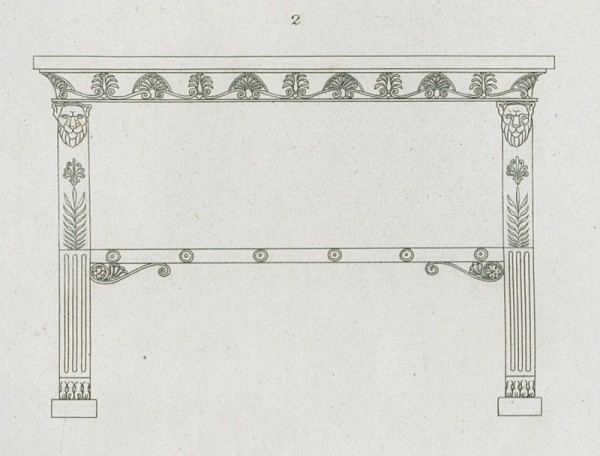
Design for a table illustrated in pl. 12 in Thomas Hope, Household Furniture and Interior Decoration (London, 1807).
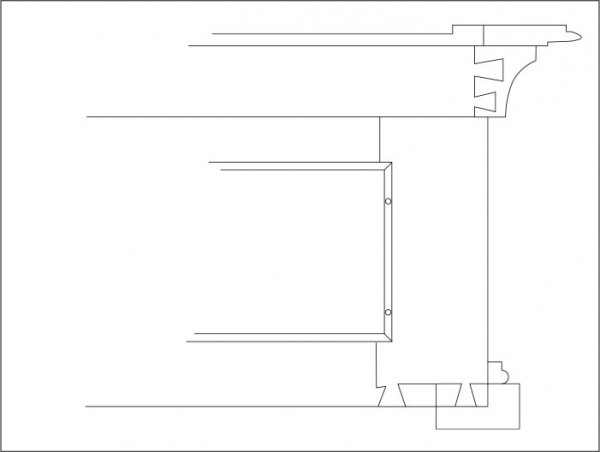
Detail of the pier table illustrated in fig. 12, showing the dovetails used to attach the pilasters to the bottom board.
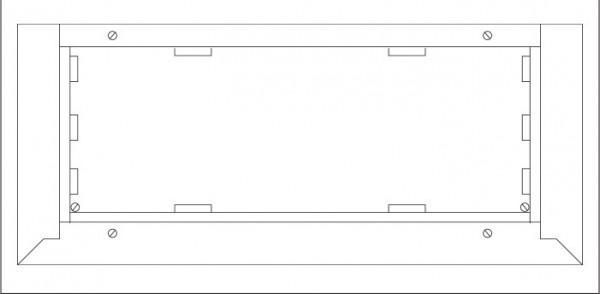
Detail of the pier table illustrated in fig. 12, showing the stepped miters of the boards above the frieze.
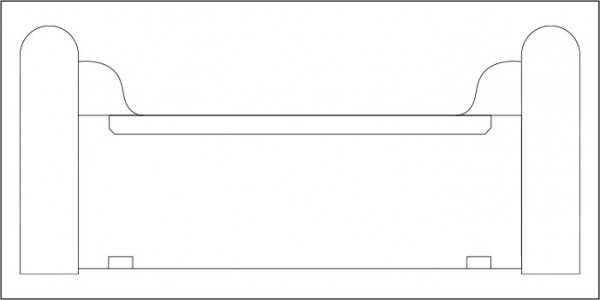
Detail of the pier table illustrated in fig. 12, showing the construction of the base.
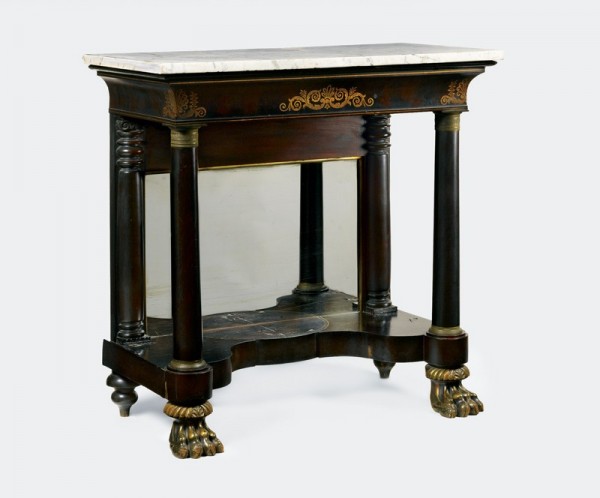
Pier table possibly by Cook & Parkin, Philadelphia, Pennsylvania, 1824–1833. Mahogany and mahogany veneer with tulip poplar; marble. H. 38", W. 38", D. 20". (Courtesy, President James Buchanan’s Wheatland, Lancaster, Pennsylvania; photo, Lancaster County Historical Society.)
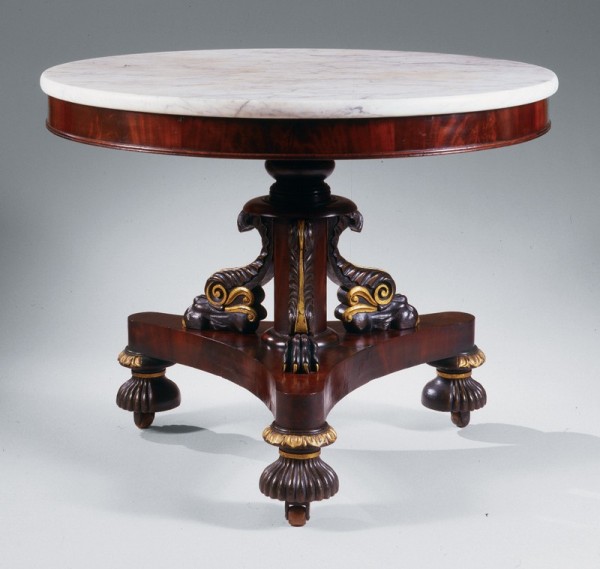
Center table bearing two stenciled labels of Cook & Parkin, Philadelphia, Pennsylvania, 1824–1833. Mahogany and mahogany veneer with white pine and ash; marble. H. 29", Diam. 38". (Courtesy, Carswell Rush Berlin, Inc.; photo, Richard Goodbody.)

Design for table à thé illustrated in pl. 515 in Pierre de la Mésangère, Collection de meubles et objets de goût (Paris, 1821). (Courtesy, Carswell Rush Berlin, Inc.)

Drum table attributed to Cook & Parkin, Philadelphia, Pennsylvania, 1824–1833. Rosewood and rosewood veneer with unidentified secondary woods. Dimensions not recorded. (Allison Boor and Jonathan Boor, Philadelphia Empire Furniture [West Chester, Pa.: Boor Management, 2006], p.129).
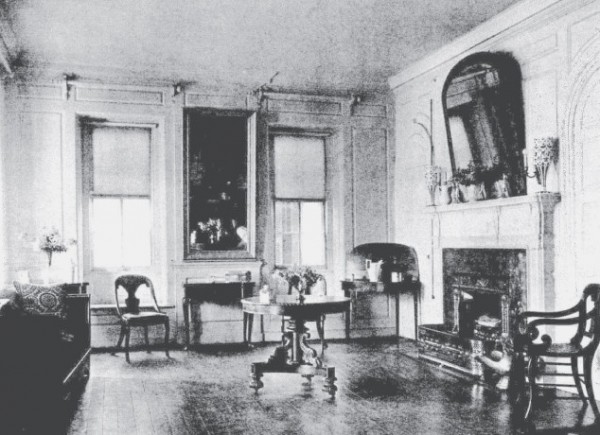
Photograph showing the second-floor parlor of the George Eveleigh House, 39 Church Street, Charleston, South Carolina, ca. 1927.
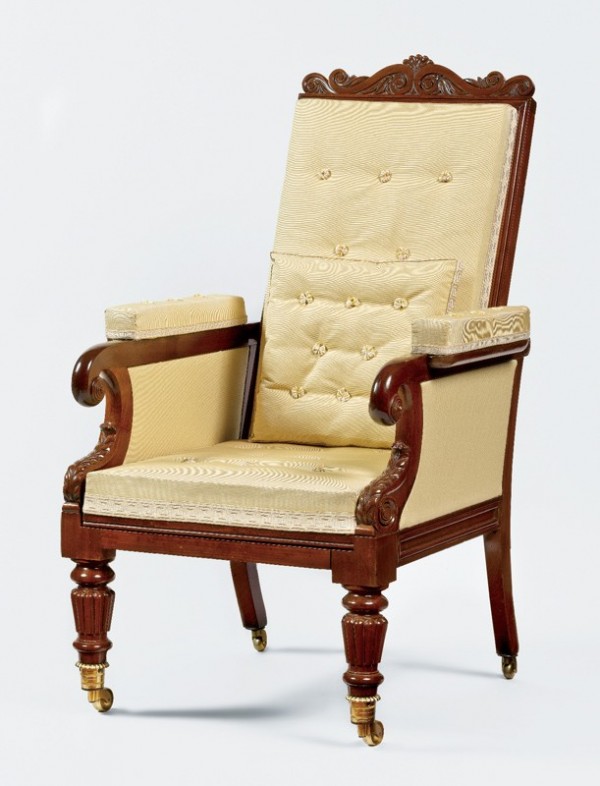
Mechanical easy chair attributed to Cook & Parkin, Philadelphia, Pennsylvania, 1824–1833. Mahogany with white pine. H. 46 1/2", W. 27 1/4", D. 29". (Courtesy, Carswell Rush Berlin, Inc.; photo, Gavin Ashworth.)

Detail of the left arm of the mechanical easy chair illustrated in fig. 23.
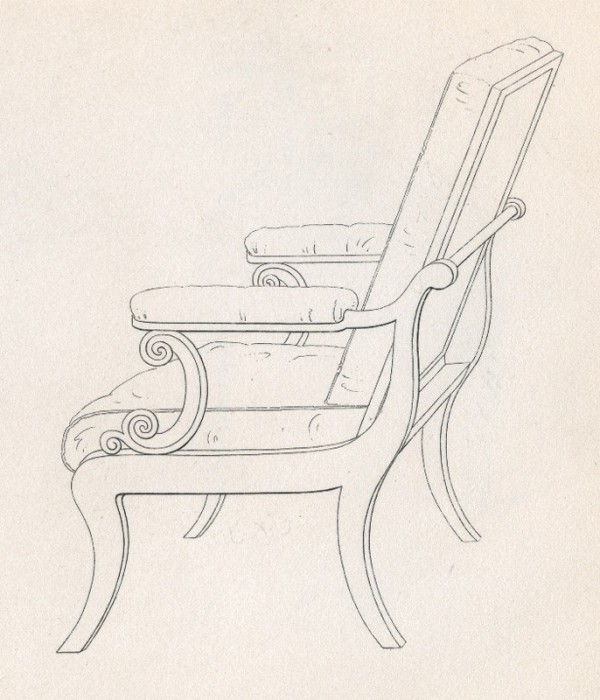
Detail of “Chairs with inclining backs” illustrated in pl. 10 in Thomas King, Modern Style of Cabinet Work Exemplified (London, 1829).

Detail of the crest of the mechanical easy chair illustrated in fig. 23.

Detail of a sideboard table illustrated in pl. 45 in Thomas King, Modern Style of Cabinet Work Exemplified (1829). (Courtesy, Carswell Rush Berlin, Inc.)
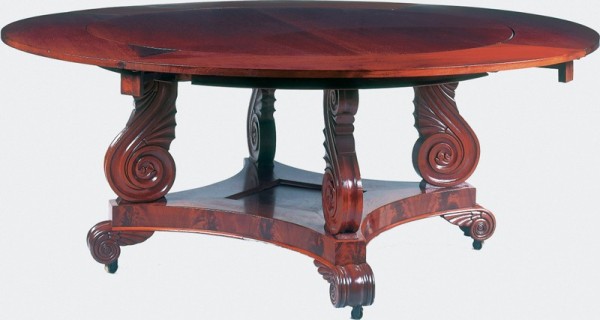
Thomas Cook, extension dining table, Philadelphia, Pennsylvania, 1836. Mahogany and mahogany veneer with white pine and oak. H. 28 1/4", Diam. 85 1/2" (with large leaves). (Courtesy, Telfair Museum of Art, Savannah, Georgia.)

Side chair, possibly Thomas Cook, Philadelphia, Pennsylvania, ca. 1830. Curly or figured maple. H. 33", W. 19", D. 22". (Courtesy, Telfair Museum of Art, Savannah, Georgia.)

Design for a dining table in pl. 31 in Thomas Sheraton, Designs for Household Furniture (London, 1812).

Design for a dining table in pl. 8 in Richard Brown, The Rudiments of Drawing Cabinet and Upholstery Furniture (London, 1820). (Courtesy, Carswell Rush Berlin, Inc.)

Designs for “Supports for Sideboard Tables” illustrated in pl. 17 in the supplement of Thomas King, The Modern Style of Cabinet Work Exemplified (London, 1829). (Courtesy, Carswell Rush Berlin, Inc.) The center design relates to the supports of the table illustrated in fig. 28.
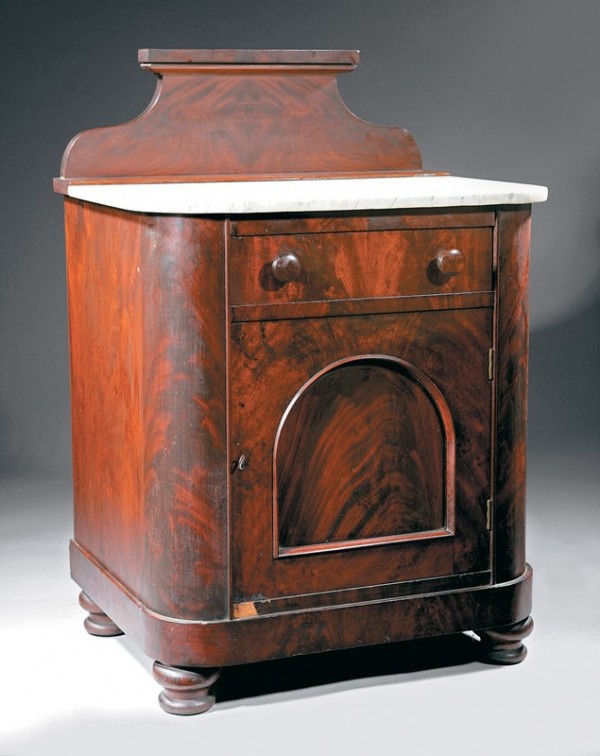
Richard Parkin, washstand, Philadelphia, Pennsylvania, 1833–1840. Mahogany and mahogany veneer with white pine; marble. H. 37", W. 26", D. 20 1/2". (Courtesy, Neal Auction Company, New Orleans, La.)

Detail of the label on the washstand illustrated in fig. 33.
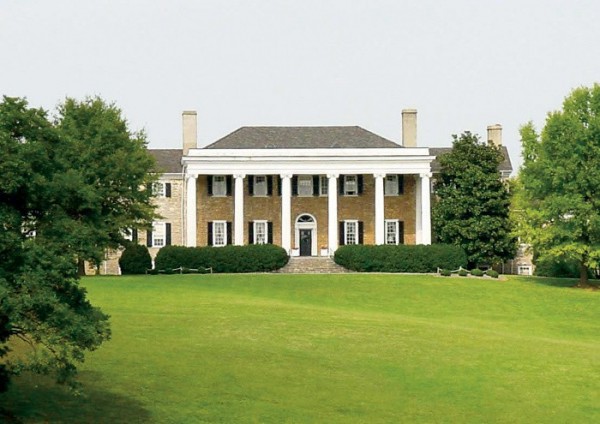
Carter Hall, Millwood, Virginia, 1814.
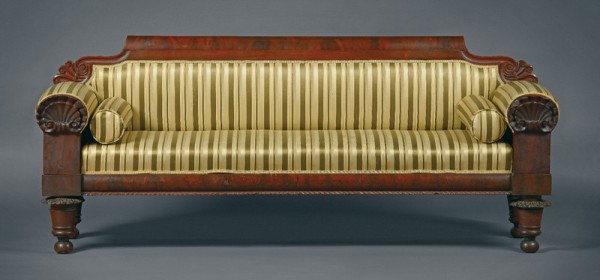
Sofa bearing the stenciled label of Cook & Parkin, Philadelphia, Pennsylvania, ca. 1830. Mahogany and mahogany veneer with unidentified secondary woods. H. 35", W. 89", D. 24 1/2". (Private collection; photo, Bob Godwin, RGB Photography, Santa Fe.)
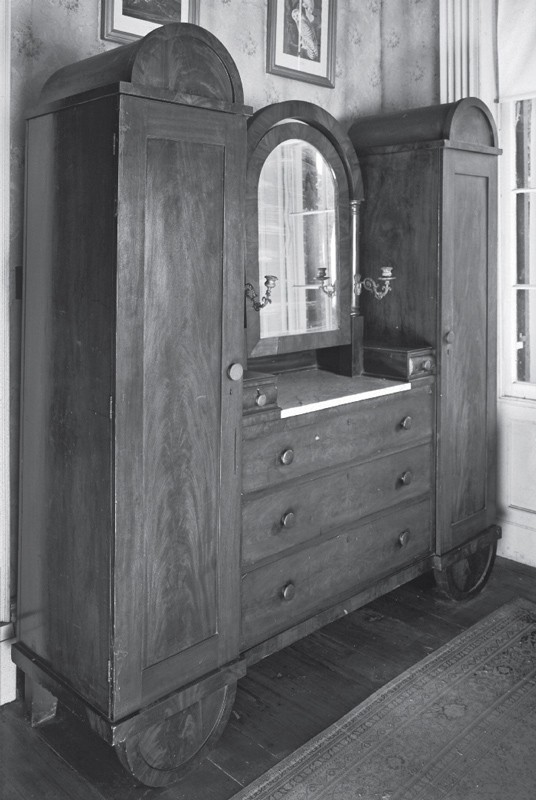
Wardrobe bearing the stenciled label of Cook & Parkin, Philadelphia, Pennsylvania, 1827–1833. Mahogany and mahogany veneer with unidentified secondary woods. H. 84 1/2", W. 80 3/4", D. 23 1/4". (Landis Valley Village and Farm Museum, Lancaster, Pennsylvania. Administered by the Pennsylvania Historical and Museum Commision; photo, Richard Sexton.) This example has five stenciled labels.

Wardrobe attributed to Cook & Parkin, Philadelphia, Pennsylvania, 1827–1833. Mahogany, mahogany veneer, maple, and maple veneer with white pine and tulip poplar. H. 87 1/2", W. 81 1/2", D. 23". (Courtesy, Charles and Rebekah Clark, Woodbury, Connecticut; photo, Gavin Ashworth.)

Bookcase attributed to Cook & Parkin or Richard Parkin, Philadelphia, Pennsylvania, 1825–1835. White pine; paint. H. 102", W. 71 3/4", D. 16 1/2". (Courtesy, Carlton Hobbs, LLC, New York.) Demilune panels like those on the cornice occur on other furniture attributed to Cook & Parkin (see figs. 37, 38). The beaded Romanesque panel of the base is a larger version of that on the door of the washstand illustrated in fig. 33. The pediment is virtually identical to that of the wardrobe illustrated in fig. 38, and both designs relate to the “large library or writing-table” shown in pl. 11 in Thomas Hope, Household Furniture (1807) (fig. 9).
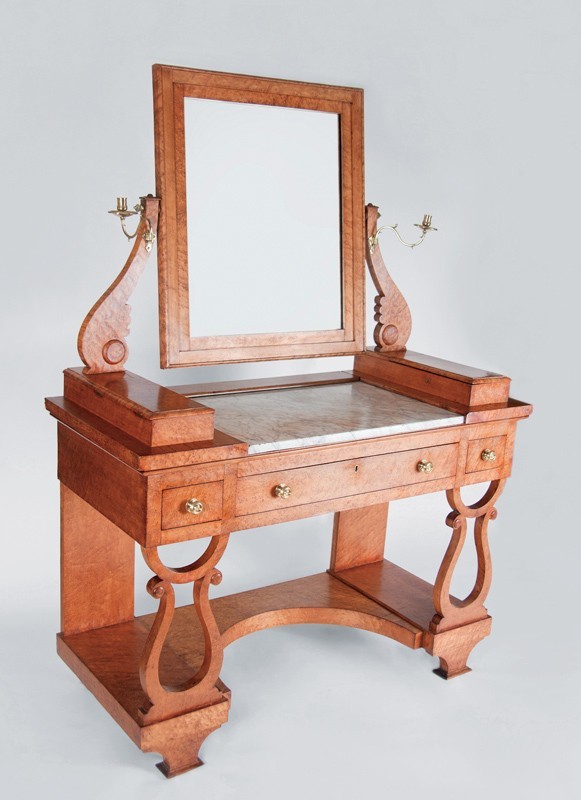
Dressing table attributed to Cook & Parkin or Richard Parkin, Philadelphia, Pennsylvania, 1829–1835. Maple and maple veneer with unrecorded secondary woods. H. 67", W. 48", D. 21 1/2". (Courtesy, Gates Antiques, Ltd., Midlothian, Virginia.) The design of this object may have been inspired by “A Toilet” illustrated in pl. 92 of Thomas King, The Modern Style of Cabinet Work Exemplified (1829). The demilune cutouts relate to the panels on the case pieces illustrated in figs. 37–39, and the large flat bosses on the mirror brackets are identical to those on the scrolls of the couch, chairs, occasional table, and sideboards illustrated in figs. 45, 51, 56, 59, and 60.
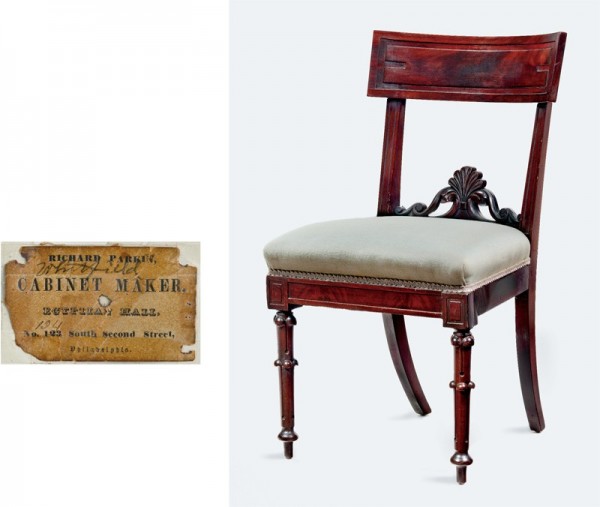
Side chair from a set of at least eleven with one bearing the label of Richard Parkin, Philadelphia, Pennsylvania, 1834–1840. Mahogany, black walnut, and mahogany veneer with walnut. H. 32", W. 18", D. 18". (Landis Valley Farm Museum, Lancaster, Pennsylvania; photo, Gavin Ashworth.) Elements of these chairs may have been inspired by designs in several pattern books, but the overall composition is original and unlike any published chair design. The form and crest rail relate to a chair illustrated in pl. 194 in Pierre de la Mésangère, Collection de muebles et objets de goût (Paris, 1805), and the legs relate to those on chairs shown in pl. 143 in George Smith, Cabinet-Maker and Upholsterer’s Guide (London, 1828), and pl. 18 in Thomas King, The Modern Style of Cabinet Work Exemplified (1829).
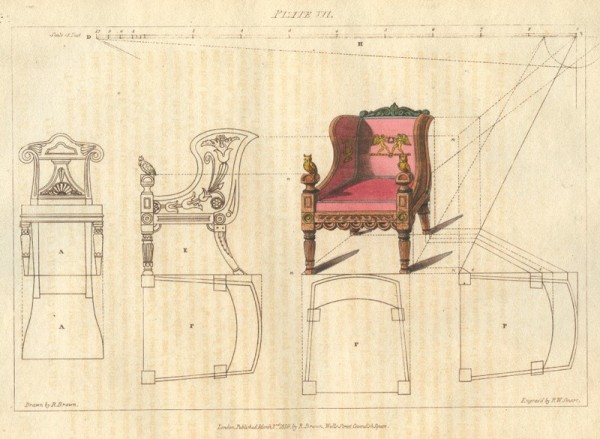
Design for a library chair illustrated in pl. 7 in Richard Brown, The Rudiments of Drawing Cabinet and Upholstery Furniture (1820). (Courtesy, Carswell Rush Berlin.) The chair on the left may have been inspired by a George Bullock design as indicated by the Wilkinson Tracings (fig. 43).

Chair designs on p. 8 in “Tracings from Thomas Wilkinson from Designs of the late Mr. George Bullock, 1820.” (Courtesy, Birmingham Museums Trust.) Several sets of Philadelphia chairs have details similar to those depicted in these “tracings.” The example on the left of the second row has a back design that relates to those on chairs documented and attributed to Parkin.
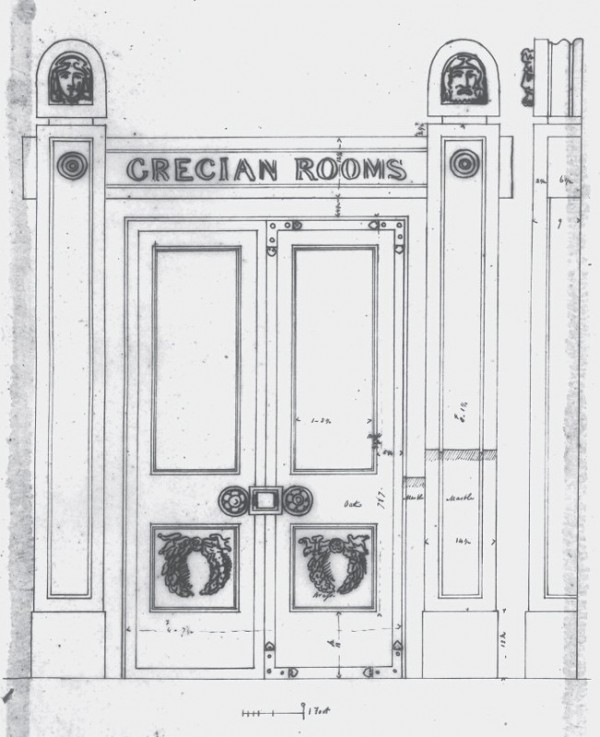
Drawing depicting the entrance to George Bullock’s Grecian Rooms at Egyptian Hall, Piccadilly, London, 1812–1814. (Courtesy, Birmingham Museums Trust.)

Armchair attributed to Richard Parkin, Philadelphia, Pennsylvania, 1833–1840. Rosewood and rosewood veneer with unrecorded secondary woods. Dimensions not recorded. (Private collection; photo, Johnny Miller.) This chair is one of three identical armchairs and six related chairs, including the example illustrated in fig. 51.
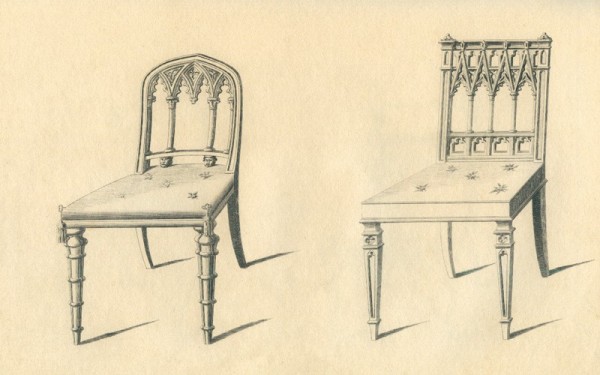
Designs for “Drawing Room and Dining Room Gothic Chairs” illustrated in pl. 143 in George Smith, Guide (1828). (Courtesy, Carswell Rush Berlin.) The chair on the left has legs similar to those on seating documented and attributed to Richard Parkin.
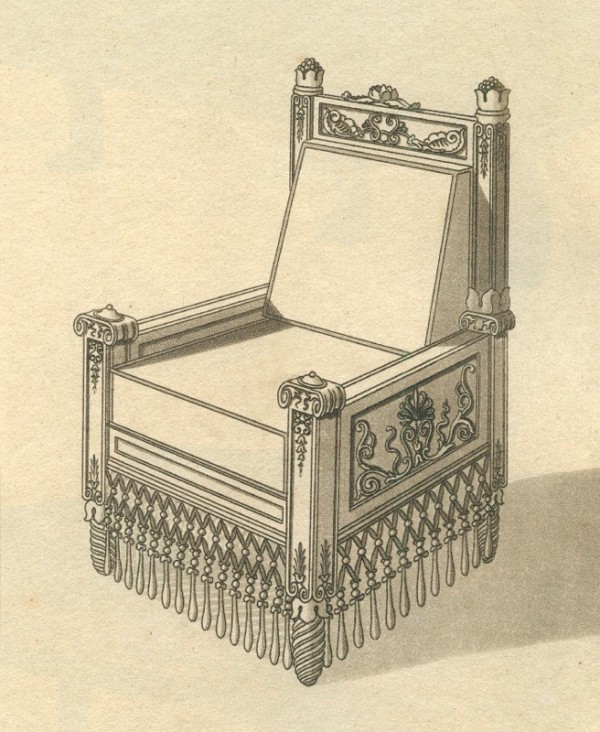
Design for a “Drawing Room State Chair” illustrated in pl. 58 in George Smith, Household Furniture (London, 1808). (Courtesy, Carswell Rush Berlin.)

Side chair attributed to Richard Parkin, Philadelphia, Pennsylvania, 1834–1840. Mahogany and mahogany veneer with ash. H. 33 1/8", W. 17 3/4", D. 21 1/2". (Courtesy, Philadelphia Museum of Art; gift of Andrew Jones and George Celio, 1996.)

Side chair attributed to Richard Parkin, Philadelphia, Pennsylvania, 1834–1840. Mahogany and mahogany veneer with tulip poplar. H. 33 1/2", W. 17 1/2", D. 21". (Courtesy, Yale University Art Gallery.)
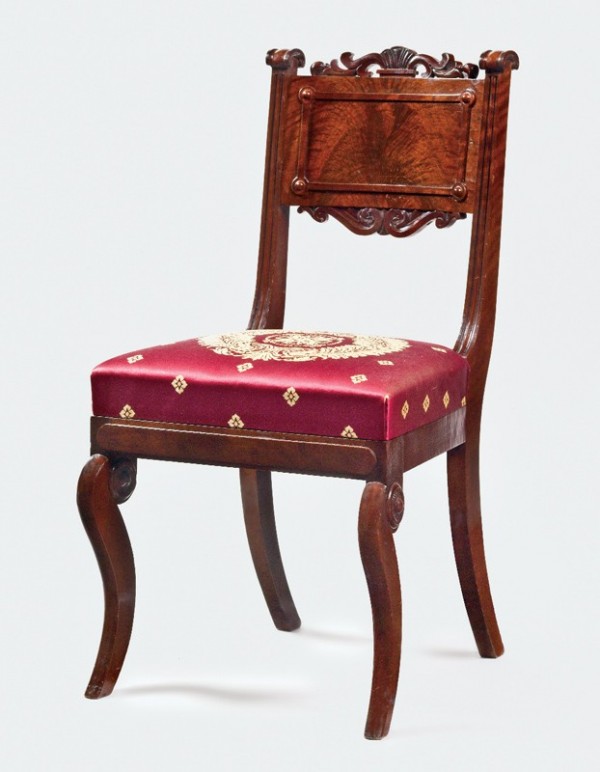
Side chair attributed to Richard Parkin, Philadelphia, Pennsylvania, 1834–1840. Mahogany, mahogany veneer, and walnut with white pine. H. 35 1/4", W. 18 1/4", D. 20 3/4". (Private collection; photo, Gavin Ashworth.)
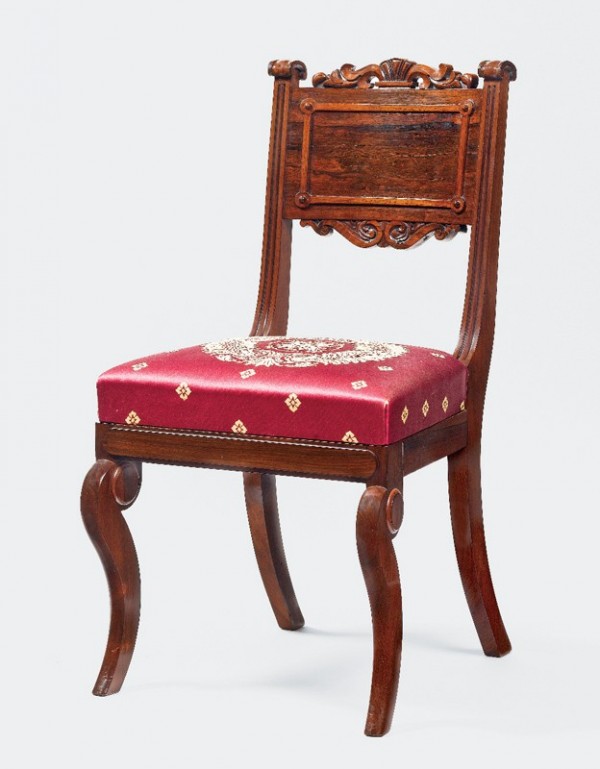
Side chair attributed to Richard Parkin, Philadelphia, Pennsylvania, 1834–1840. Rosewood and rosewood veneer with ash. H. 35 1/4", W. 18 1/4", D. 20 1/2". (Private collection; photo, Gavin Ashworth.)
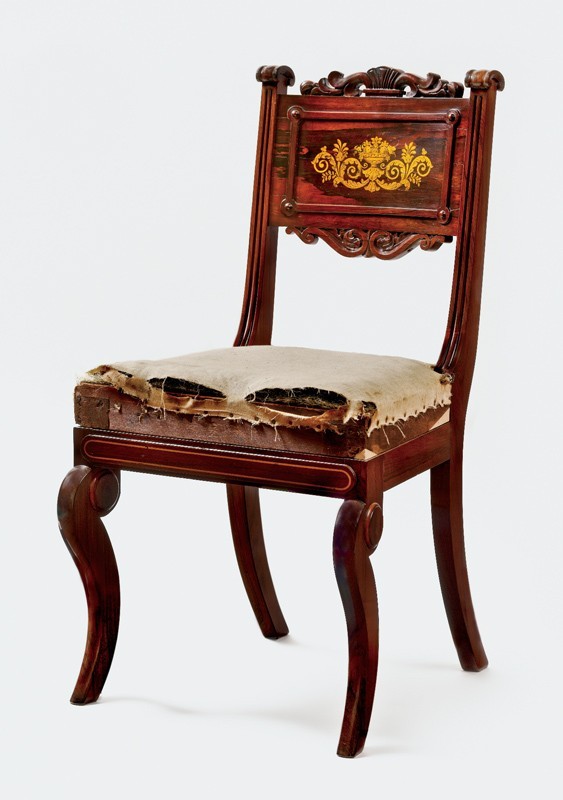
Side chair attributed to Richard Parkin, Philadelphia, Pennsylvania, 1834–1840. Rosewood and rosewood veneer with ash. H. 35 1/4", W. 18 1/4", D. 20 1/2". (Private collection; photo, Gavin Ashworth.)

Footstool from a pair bearing the label of Richard Parkin, Philadelphia, Pennsylvania, 1834–1840. Woods not identified. (William MacPherson Horner Jr., “Some Early Philadelphia Cabinetmakers,” Antiquarian 16, no. 3 [March 1931]: 76.) Parkin’s design is similar to that of a footstool illustrated in Rudolph Ackermann, The Repository of Arts, Literature, Commerce, and Manufactures, ser. 1, vol. 10 (October 1813): 232, pl. 25. This publication was very influential, particularly in Philadelphia.
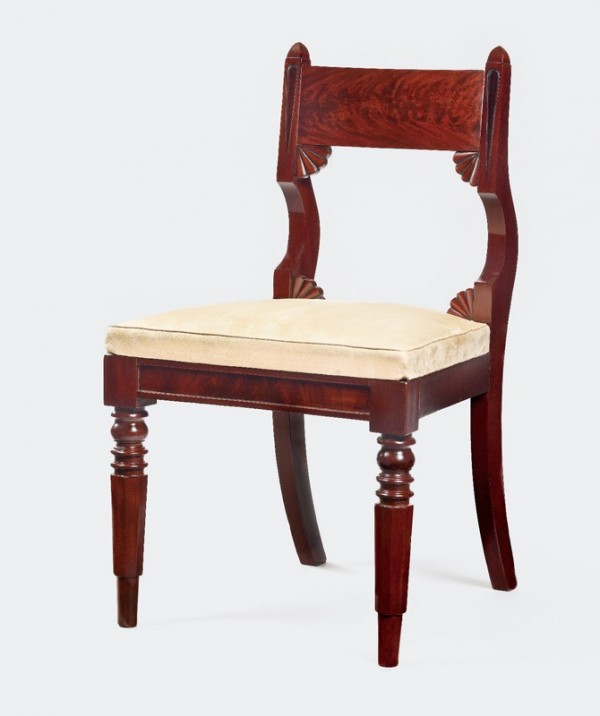
Side chair, possibly from the shop of Richard Parkin, Philadelphia, Pennsylvania, 1834–1840. Mahogany and mahogany veneer with ash. H. 33", W. 19", D. 20". (Courtesy, Carswell Rush Berlin, Inc.; photo, Richard Goodbody.) This chair is from a set of at least twelve seating forms. Its crest rail is related to that on the side chair illustrated in fig. 49, and its faceted legs are similar to those on the armchair illustrated in fig. 55.
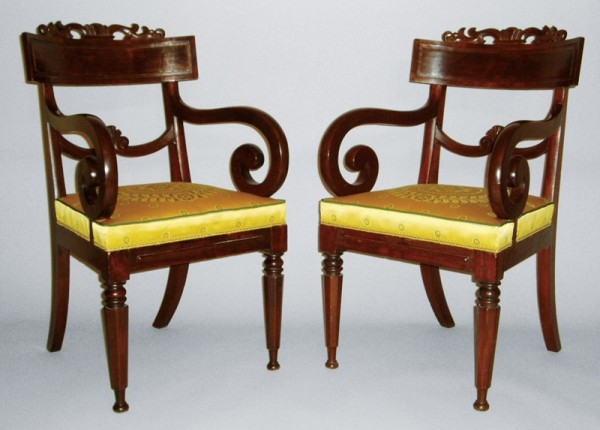
Armchairs attributed to the shop of Richard Parkin, Philadelphia, Pennsylvania, 1834–1840. Walnut and walnut veneer. Secondary woods not recorded. H. 35", W. 19 1/4", D. 16 3/4". (Private collection; photo, Johnny Miller.)
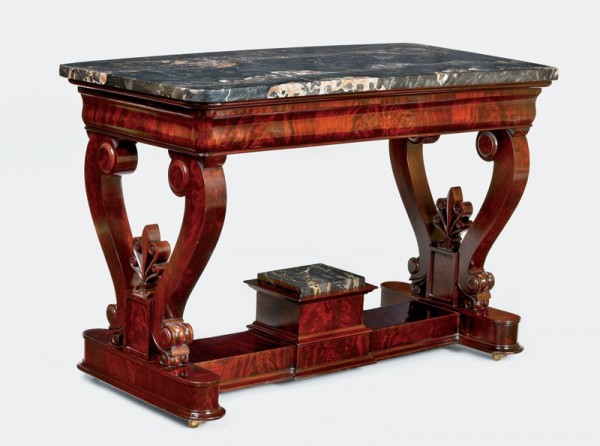
Occasional table bearing the Egyptian Hall label of Richard Parkin, Philadelphia, Pennsylvania, 1835–1840. Mahogany and mahogany veneer with white pine. H. 29 1/2", W. 44", D. 22". (Private collection; photo, Gavin Ashworth.)
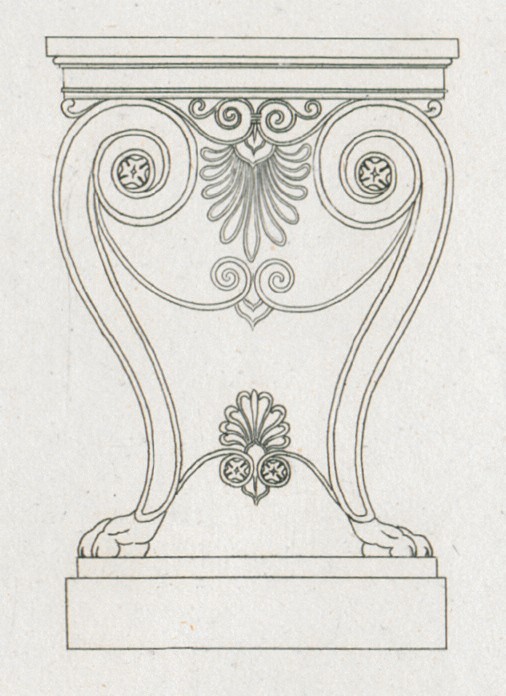
Design for a table illustrated in pl. 12 in Thomas Hope, Household Furniture and Interior Decoration (1807). This form is referred to as an “occasional table” in Peter Nicholson and Michael Angelo Nicholson, The Practical Cabinet Maker, Upholsterer and Complete Decorator (London, 1826), George Smith, Cabinet Maker and Upholsterer’s Guide (1828), and Thomas King, The Modern Style of Cabinet Work Exemplified (1829).

Profile of an “Antique Seat of Parian Marble in a Chapel near Rome” in Charles Heathcote Tatham, Etchings Representing the Best Examples of Ancient Ornamental Architecture; Drawn from the Originals in Rome (London, 1799). Several published designs can be traced to this etching.
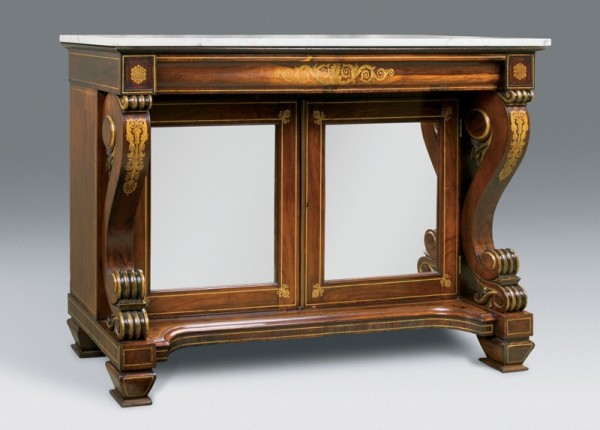
Sideboard attributed to Richard Parkin, Philadelphia, Pennsylvania, ca. 1835. Rosewood and rosewood veneer with mahogany, white pine, tulip poplar, and cedrela; marble. H. 40 3/4", W. 60 1/4", D. 22". (Courtesy, Philadelphia Museum of Art, 1976-17-1.)
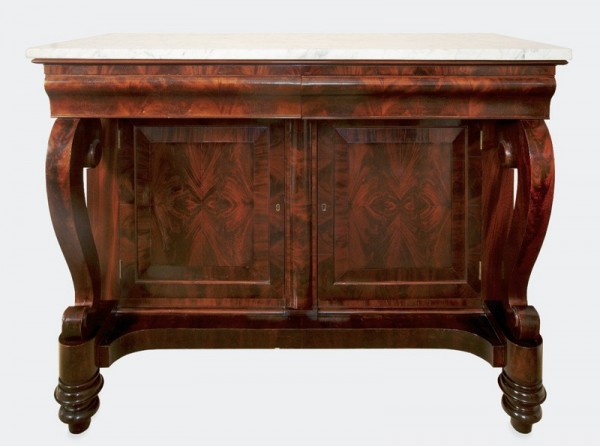
Sideboard probably by Richard Parkin, Philadelphia, Pennsylvania, 1835. Mahogany and mahogany veneer with white pine; marble. H. 43", W. 60", D. 24". (Courtesy, Rosedown Plantation Historic Site, St. Francisville, Louisiana.) Made for Rosedown Plantation and invoiced by Anthony G. Quervelle, exhibiting distinctive flat bosses.
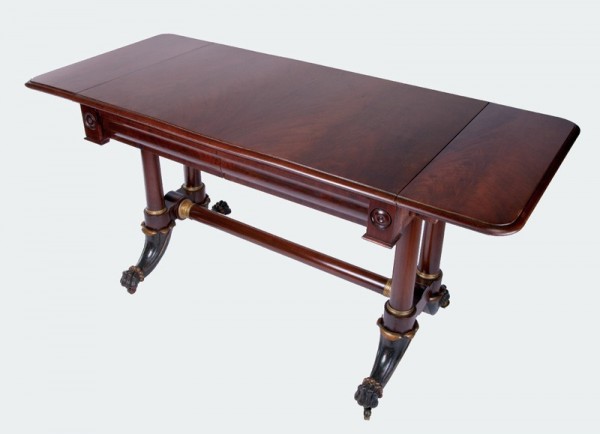
David Bodensick, sofa table, Baltimore, Maryland, 1833. Mahogany and mahogany veneer with white pine and tulip poplar. H. 29 1/8", W. 57 3/4 (open)", D. 26". (Courtesy, Maryland Historical Society, 1990.3.) The table is inscribed, “Made by / David Bodensick From Baltimore / And Sold By Mr. Cook & Perkins / Philadelphia, PA.”
